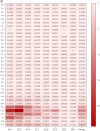Diverse Malaria Presentations across National Institutes of Health South Asia International Center for Excellence in Malaria Research Sites in India
- PMID: 36228910
- PMCID: PMC9662227
- DOI: 10.4269/ajtmh.21-1344
Diverse Malaria Presentations across National Institutes of Health South Asia International Center for Excellence in Malaria Research Sites in India
Abstract
The Malaria Evolution in South Asia (MESA) International Center for Excellence in Malaria Research (ICEMR) was established by the US National Institutes of Health (US NIH) as one of 10 malaria research centers in endemic countries. In 10 years of hospital-based and field-based work in India, the MESA-ICEMR has documented the changing epidemiology and transmission of malaria in four different parts of India. Malaria Evolution in South Asia-ICEMR activities, in collaboration with Indian partners, are carried out in the broad thematic areas of malaria case surveillance, vector biology and transmission, antimalarial resistance, pathogenesis, and host response. The program integrates insights from surveillance and field studies with novel basic science studies. This is a two-pronged approach determining the biology behind the disease patterns seen in the field, and generating new relevant biological questions about malaria to be tested in the field. Malaria Evolution in South Asia-ICEMR activities inform local and international stakeholders on the current status of malaria transmission in select parts of South Asia including updates on regional vectors of transmission of local parasites. The community surveys and new laboratory tools help monitor ongoing efforts to control and eliminate malaria in key regions of South Asia including the state of evolving antimalarial resistance in different parts of India, new host biomarkers of recent infection, and molecular markers of pathogenesis from uncomplicated and severe malaria.
Figures



Similar articles
-
International Center of Excellence for Malaria Research for South Asia and Broader Malaria Research in India.Am J Trop Med Hyg. 2022 Oct 11;107(4_Suppl):118-123. doi: 10.4269/ajtmh.22-0005. Print 2022 Oct 11. Am J Trop Med Hyg. 2022. PMID: 36228906 Free PMC article.
-
Malaria evolution in South Asia: knowledge for control and elimination.Acta Trop. 2012 Mar;121(3):256-66. doi: 10.1016/j.actatropica.2012.01.008. Epub 2012 Jan 14. Acta Trop. 2012. PMID: 22266213 Free PMC article. Review.
-
Malaria in South Asia: prevalence and control.Acta Trop. 2012 Mar;121(3):246-55. doi: 10.1016/j.actatropica.2012.01.004. Epub 2012 Jan 8. Acta Trop. 2012. PMID: 22248528 Free PMC article. Review.
-
Malaria in India: the center for the study of complex malaria in India.Acta Trop. 2012 Mar;121(3):267-73. doi: 10.1016/j.actatropica.2011.11.008. Epub 2011 Nov 28. Acta Trop. 2012. PMID: 22142788 Free PMC article.
-
Malaria Surveillance - United States, 2016.MMWR Surveill Summ. 2019 May 17;68(5):1-35. doi: 10.15585/mmwr.ss6805a1. MMWR Surveill Summ. 2019. PMID: 31099769
Cited by
-
International Center of Excellence for Malaria Research for South Asia and Broader Malaria Research in India.Am J Trop Med Hyg. 2022 Oct 11;107(4_Suppl):118-123. doi: 10.4269/ajtmh.22-0005. Print 2022 Oct 11. Am J Trop Med Hyg. 2022. PMID: 36228906 Free PMC article.
References
-
- NVBDCP , 2016. National Framework for Malaria Elimination in India 2016–2030.
-
- NVBDCP , 2017. National Strategic Plan Malaria Elimination in India (2017–2022). Available at: https://nvbdcp.gov.in/WriteReadData/l892s/nsp_2017-2022.pdf. Accessed August 29, 2022.
Publication types
MeSH terms
Substances
Grants and funding
LinkOut - more resources
Full Text Sources
Medical

